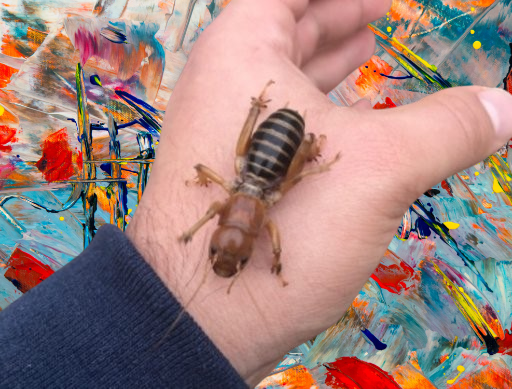
Jerusalem cricket, also known as potato bug or earth baby, is an interesting insect that is often misunderstood. It is found mainly in the western United States and some states of Mexico. Yet, ironically enough, this insect bears neither resemblance to a true cricket nor any connection whatsoever with Jerusalem at all, despite its name. In this article, we will explore the interesting life of Jerusalem Crickets starting right from their simple beginnings as eggs to their adult forms.
The Fascinating Jerusalem Cricket
Before we explore the lifecycle, it is crucial to know what makes Jerusalem cricket’s so intriguing. The Jerusalem cricket’s a large insect that belongs to the genus Stenopelmatus and flies no more! It is an insect found in the order Orthoptera which also includes grasshoppers as well as katydids. They often surprise people because of their peculiar features including big round heads, human-like faces, and strong bodies. Even though they appear scary, these crickets are not harmful to human beings’ health and are essential for many ecosystems.
Egg Stage
Laying of Eggs
Jerusalem cricket eggs’ beginnings mark the egg stage. After mating, female Jerusalem crickets look for soil locations that are suitable for laying their eggs. They often select places that have loose, moist soils to safely protect them in this controlled atmosphere needed by the developing embryos.
Egg Characteristics
Jerusalem cricket eggs are oval, creamy-colored, and measure approximately 2-3 mm long. A female lays a cluster of 15-30 eggs at once by carefully placing them into little compartments or burrows dug in the ground. The eggs have a sticky substance covering them giving them an adhesion quality that makes them stick to each other as well as to nearby earth particles for extra security.
Incubation Period
Depending on environmental factors like temperature and humidity, the time it takes for Jerusalem cricket eggs to hatch can differ. Typically, it takes three to four months. During this period, the embryos in the eggs are gradually maturing into small nymphs which will soon break out.
Nymph Stage
First Instar
Upon hatching, they are known as first instars for the newly emerged nymphs. They are small, pale, and without any hard parts measuring only a few mm long. In appearance, these small creatures resemble baby adults of the Jerusalem cricket but do not have complete characteristics.
Subsequent Instars
As they develop, nymphs molt several times, growing in size by shedding their exoskeletons. Each molt is a signal for an advancing stage called instar; usually, Jerusalem crickets have six to eight instars before they become mature. Every time the nymphs shed their skins, they grow larger and start looking more like adult Jerusalem crickets, both in color and size.
Nymphal Development
Throughout this period of nymph stage that lasts 6 months to over a year, young Jerusalem crickets undergo considerable transformations characterized by the development of powerful mandibles meant for digging and feeding, stronger legs, and more rugged overall body structure. Nymphs remain below ground in the meantime feeding on roots, tubers, and other decaying materials within the soil.
Read Also : How To Play Darts: Cricket Dart Board Rules
Adult Stage
Physical Characteristics
Adult Jerusalem crickets grow to their maximum size and distinct look. The adults are usually 1.5 to 2 inches (3.8 to 5.1 cm) long, and females are seldom smaller than males. Their bodies are thick and cylindrical with a big rounded head bearing strong jaws as well as tiny eyes. The thorax is shield-shaped and they have six powerful legs which serve the purpose of getting into the soil. Jerusalem crickets possess a yellowish-brown hue marked by dark bands along their abdomen giving them an unusual and slightly scary appearance.
Behavior and Habitat
Adult Jerusalem crickets mainly come out at night and often stay underground. They are good at digging, using their strong legs and jaws to make long tunnel networks within the ground. These tunnels are used for hiding, hunting, and breeding. Jerusalem crickets eat anything like vegetation from around plant roots, tubers, or sometimes small invertebrates which they find when digging in the earth.
Mating and Reproduction
Jerusalem crickets have a distinct mating ritual that occurs when they are sexually mature. The males make a gentle drumming sound by tapping their abdomens on the floor, which lures females to come closer. They meet and converse face-to-face with the use of their antennae, interpreting mutual signals about whether one is a good candidate for the other. In turn, mating initiates egg-laying among females, marking an end to this life cycle and the beginning of another.
Lifespan and Survival Challenges
A Jerusalem cricket’s life cycle which includes an egg stage and then transition to adulthood may vary from one year up to two years depending on climate and food source availability. The adult form of Jerusalem cricket often lives between six months to one year after maturation. Throughout its life span, this insect is confronted by many dangers. It is constantly threatened by various predators like birds, rodents, and snakes. In addition, environmental aspects such as droughts, heat waves, or high altitudes may also affect the number of Jerusalem crickets living at any given time.
Ecological Importance
Despite their fearsome appearance, Jerusalem crickets are essential in the ecosystems. Soil insects help to aerate the soil as well as participate in nutrient cycling. They also help keep other underground invertebrate populations at bay as they feed on decaying plant matter thereby decomposing it, they serve as food for many predators making them significant links within the food chain of that environment.
Conclusion
From egg to adult, the life cycle of Jerusalem cricket is represented by the remarkable journey of growth, adaptation, and survival. These unusual insects have evolved to thrive in shocking environments through their unique appearance and way of life underground. Learning about their life cycle does not only satisfy our curiosity about these interesting creatures but also emphasizes how intricate balance exists in nature hence the need for preserving various ecosystems. The more we study these crickets from Jerusalem, the more we realize what an intricate web of life is hidden under our feet.
Frequently Asked Questions (FAQ)
To respond to some common concerns about Jerusalem crickets and their life cycle below are answers to some frequently asked questions:
Q1: Are Jerusalem crickets dangerous to humans?
A: Although Jerusalem crickets may bite if handled roughly they are generally not harmful. The bite can be painful due to the strength of their mandibles but they aren’t venomous and avoid humans most times.
Q2: How long does it take for Jerusalem crickets to reach adulthood?
A: This may vary from one egg to another but it typically takes between 1-2 years for a Jerusalem cricket to undergo complete metamorphosis before becoming an adult.



